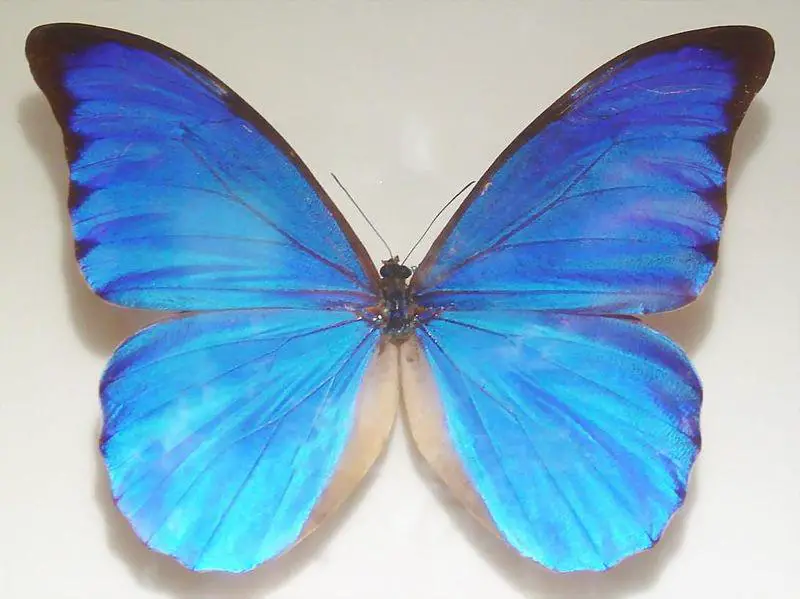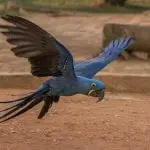The Menelaus blue morpho (scientifically named as Morpho menelaus) is a butterfly that belongs to the subfamily Morphinae. It resides in the rainforests of Central and South America. It has large iridescent blue wings which make it valuable to collectors and are an area of interest in research.
Appearance
Dorsal appearance of the Morpho butterfly
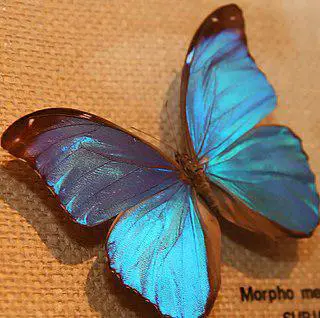
Ventral appearance of the Morpho butterfly
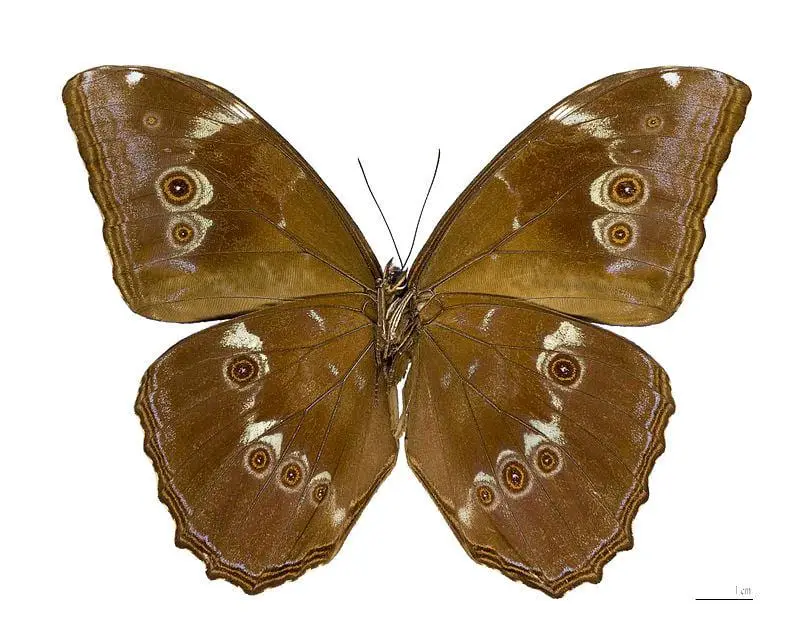
· The blue morpho butterfly has a large wingspan of about 12 cm. The wings are made up of alternating layers of chitin and air. This gives it a multiplicity of refractive indices.
· It has metallic blue and green colors on its upper wing surface. The wing consists of slits attached to a base of melanin. The slits are spaced in such a way that blue light undergoes constructive interference to produce the blue iridescence of its wings. The melanin base absorbs light, strengthening the blue appearance of the wing. The hue changes according to the angle at which the surface is viewed. Nevertheless, the coloring is uniform throughout the wing. This is attributed to the tetrahedral diamond-like arrangement of the scales of its wing, giving it the structure of a ‘photonic crystal’.
· The underside of its wing is often a mixture of brown, gray, black and red and resembles foliage. These colors result from normal organic pigments.
· Males are more vividly colored than females. This helps them to easily scare rivals that intrude into their territory away. They can be spotted from large distances due to the same.
· The ventral sides of the wings of all Morpho butterflies have ‘ocelli’ or eyespots.
· They have two antennae attached to the head. The antennae are sensory organs used to pick up the scents of flowers and mates. They also help with movement and balance.
Habitat
The blue Morpho is a Neotropical territorial butterfly that lives in the rainforests of Central and South America. They are also spotted in the tropical Savannah of Brazil and in Mexico and Venezuela.
Life Cycle
· Like other butterflies the blue Morpho undergoes four phases of metamorphosis.
· The butterflies lay eggs on the undersides of plants. These eggs are pale green and small, causing them to resemble dew drops.
· Caterpillars are the larvae that hatch from eggs in large numbers during the dry season. They are reddish brown in color with green spots. They have bristles on their body which release irritant chemicals upon contact. They eat the new leaves of host plants.
· Caterpillars after a while wrap themselves in enclosures called ‘chrysalises’. At this stage the insects are called pupae. As they mature, adult butterflies emerge out of the chrysalis.
· Adults emerge mainly in the wet season when food is in plenty. Adults freely roam in forested and open areas. The butterfly spends up to 4 weeks in the adult stage during which oviposition takes place. The entire life cycle has a duration of about 115 – 140 days.
Feeding Habits
· Caterpillars chew leaves of various plants and trees. Leaves of plants of the pea family are a favorite.
· The adult Morpho menelaus butterfly can no longer chew. It uses its long proboscis to drink rather than eat its food, which is mostly sap and fruit juices. They taste their food with the help of sensors on their legs.
· Fermenting fruit is one of the adult Morpho’s favorite foods.
· They also consume the bodily fluids of dead animals and fungi. This makes them important to the dispersal of fungal spores.
Behavior
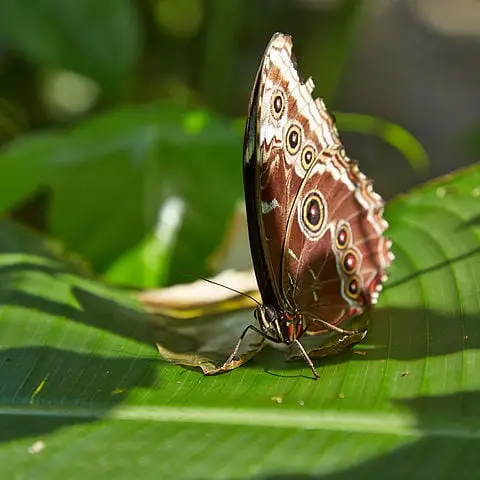
· Morpho butterflies are diurnal creatures. In the night they exhibit ‘crypis’. This means that while sleeping at night, they fold their wings showing only the dark underside. This effectively camouflages them from predators.
· Adults spend most of their lives in the lower sections of the forest. This includes the lower shrubs and the forest floor. However, they venture out to all the forest layers and open areas in search for mates. They may rest on treetops in large numbers warming themselves in the sun after heavy rains.
· They demonstrate a ‘flashing’ defense mechanism. They beat their wings slowly causing the iridescent blue color to flash, disappear and then reappear in another place after a short interval. This makes it look like the butterfly is appearing and disappearing. Hence catching only glimpses of the intermittent blue flashes, predators lose track of the butterfly as it flies away from them.
· Their eyes of males are sensitive to UV light, enabling them to see each other at very large distances.
· The wings of the blue Morpho butterfly have a super-hydrophobic surface. This causes water to form a ball and roll off the surface as it falls on the wing. The water removes any dirt on the wing as it rolls off. It is one of the few butterflies that fly in the rain. The microstructure of the wing causes it to have this unique feature.
· The ventral side of the wing has eyespots which is dark with light outer rims. They have a sparkle that resembles that of the cornea of the eye. The eyespots or ‘ocelli’ resemble the eyes of larger vertebrates. They serve to drive predators away from the vital organs of the butterfly.
· Some caterpillars have shown cannibalistic behavior. When disturbed the caterpillars secrete a fluid with the smell of rancid butter. They have tufts of hair on their bodies which are irritating to human skin.
· Adult blue Morpho butterflies are poison sequestering animals. This means that they accumulate poisonous compounds from the environment in order to become poisonous themselves. This discourages predators from consuming them.
The unique appearance of the Morpho menelaus butterfly makes it one of the most recognizable neotropical insects. This has resulted in a widespread collection of these butterflies by collectors, designers and artists. They are also hunted for decorative purposes. The Morpho’s wings’ unique characteristics make it a worthy subject of a lot of ongoing research. The bioengineering field has been interested in understanding the structure of its wing as it could have several applications in the production of structural-color devices and gas-sensors.

